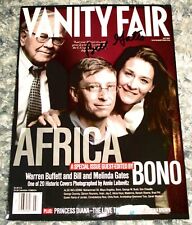Vanity Fair Magazine Print Lithograph Statesman No. 14 Earl Grey Signed Royalty

When you click on links to various merchants on this site and make a purchase, this can result in this site earning a commission. Affiliate programs and affiliations include, but are not limited to, the eBay Partner Network.
Vanity Fair Magazine Print Lithograph Statesman No. 14 Earl Grey Signed Royalty :
$1099.96
LOT-LSE111. For your consideration is an exceedingly rare and historically important Vanity Fair magazine print of Earl Grey, hand-signed by Henry George Grey in 1869. Royal autograph is manuscript hand-signed in black fountain pen ink. Condition is original. Print is original. Nicely framed. Henry George Grey, 3rd Earl Grey; ('Statesmen, No. 14. "A privileged person."') by Carlo Pellegrini. Chromolithograph, published in Vanity Fair 8 May 1869. Chromolithograph print measures approximately 14 1/8 in. x 9 1/2 in. (359 mm x 242 mm) paper size. Framed approximately 11.0" x 15.5". Museum quality. One of a kind. Guaranteed authentic.
Henry George Grey, 3rd Earl Grey KG GCMG PC (28 December 1802 – 9 October 1894), known as Viscount Howick from 1807 until 1845, was an English statesman and cabinet minister in the government of the United Kingdom.
Grey was the eldest son of Charles Grey, 2nd Earl Grey, who served as Prime Minister in the 1830s, by his wife The Honorable Mary Ponsonby, daughter of William Ponsonby, 1st Baron Ponsonby.
He matriculated at Trinity College, Cambridge in 1821, graduating with a nobleman's MA in 1823.
possible; the first to introduce free trade into their relations with Great Britain and Ireland. The concession by which colonies were allowed to tax imports from the mother-country ad libitum was not his; he protested against it, but was overruled. In the West Indies he suppressed, if he could not overcome, discontent; in Ceylon he put down rebellion; in New Zealand he suspended the constitution he had himself accorded, and yielded everything into the hands of Sir George Grey. The least successful part of his administration was his treatment of the convict question at the Cape of Good Hope, which seemed an exception to his rule that the colonies were to be governed for their own benefit and in accordance with their own wishes, and subjected him to a humiliating defeat.
Frustrated that plans for a loan to relieve the Irish famine and fund emigration schemes from the area had failed Grey developed his plans for an alternative currency system to the Bank of England central bank model. It became known as a currency board and he set up the first one in cooperation with James Wilson and the Mauritian colonial government in Mauritius.
In 1848 Grey was elected to the New South Wales Legislative Council representing the City of Melbourne despite never visiting the colony; his seat was declared vacant in 1850 due to his non-attendance. This election was a protest against rule from Sydney and in 1850 Grey introduced the Australian Colonies Government Act which separated the district from New South Wales to become the colony of Victoria.
After his retirement he wrote a history and defence of his colonial policy in the form of letters to Lord John Russell (Colonial Policy of Lord John Russell's Administration, 1853). He resigned with his colleagues in February 1852. No room was found for him in the Aberdeen ministry formed in December that year, and although during the Crimean struggle public opinion pointed to him as the fittest man as minister for war, he never again held office. During the remainder of his long life he exercised a vigilant criticism on public affairs. In 1858 he wrote a work (republished in 1864) on parliamentary reform; in 1888 he wrote another on the state of Ireland; and in 1892 one on the United States tariff. In his latter years he was a frequent contributor of weighty letters to The Times on land, tithes, currency and other public questions. His principal parliamentary appearances were when he moved for a committee on Irish affairs in 1866, and when in 1878 he passionately opposed the policy of the Beaconsfield cabinet in India. He nevertheless supported Lord Beaconsfield at the dissolution, regarding William Ewart Gladstone's accession to power with much greater alarm. He was a determined opponent of Gladstone's Home rule policy.
Vanity Fair Magazine Print Lithograph Statesman No. 14 Earl Grey Signed Royalty :
$1099.96

Related Items:
Bill Gates Rare 2007 Signed Vanity Fair Magazine Cover , Microsoft
$1800.00
EMMA WATSON AUTOGRAPH SIGNED VANITY FAIR MAGAZINE ACOA
$1500.00
Vanity Fair Magazine Print Lithograph Statesman No. 14 Earl Grey Signed Royalty
$1031.21







